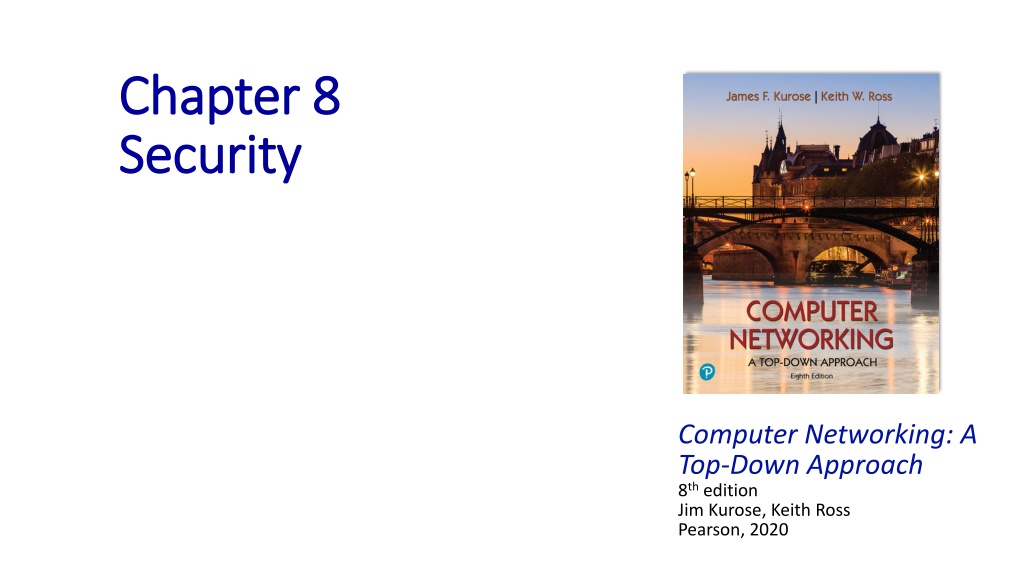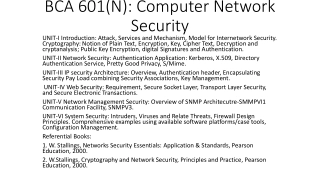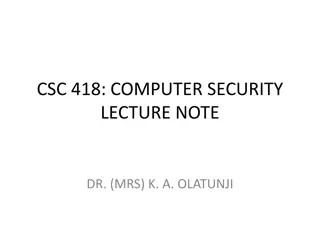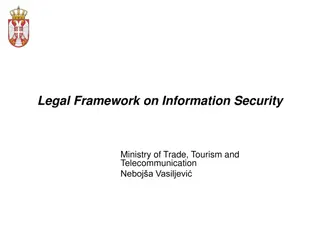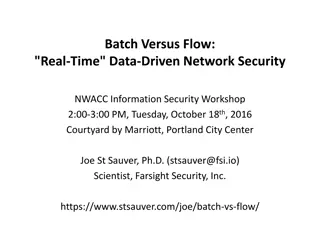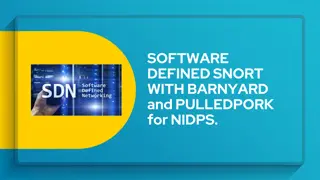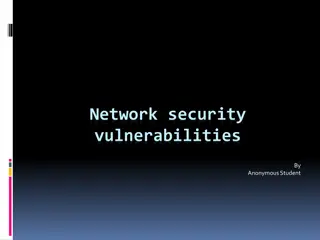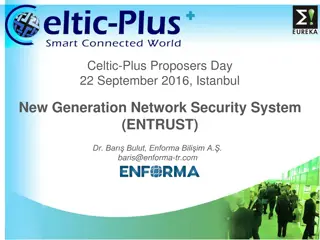Network Security: A Top-Down Approach Overview
This content delves into the fundamental principles of network security, covering topics such as cryptography, authentication, message integrity, and security measures at different network layers. It explores the concepts of confidentiality, authentication, message integrity, access, and availability in ensuring secure communication. The narrative introduces key players in network security scenarios like Alice, Bob, and Trudy, highlighting their roles and interactions in secure communication settings.
Uploaded on Nov 23, 2024 | 0 Views
Download Presentation

Please find below an Image/Link to download the presentation.
The content on the website is provided AS IS for your information and personal use only. It may not be sold, licensed, or shared on other websites without obtaining consent from the author.If you encounter any issues during the download, it is possible that the publisher has removed the file from their server.
You are allowed to download the files provided on this website for personal or commercial use, subject to the condition that they are used lawfully. All files are the property of their respective owners.
The content on the website is provided AS IS for your information and personal use only. It may not be sold, licensed, or shared on other websites without obtaining consent from the author.
E N D
Presentation Transcript
Chapter 8 Chapter 8 Security Security Computer Networking: A Top-Down Approach 8th edition Jim Kurose, Keith Ross Pearson, 2020
Security: overview Security: overview Chapter goals: understand principles of network security: cryptography and its manyuses beyond confidentiality authentication message integrity security in practice: firewalls and intrusion detection systems security in application, transport, network, link layers Security: 8- 2
Chapter 8 outline Chapter 8 outline What is network security? Principles of cryptography Message integrity, authentication Securing e-mail Securing TCP connections: TLS Network layer security: IPsec Security in wireless and mobile networks Operational security: firewalls and IDS Security: 8- 3
What is network security? What is network security? confidentiality: only sender, intended receiver should understand message contents sender encrypts message receiver decrypts message authentication: sender, receiver want to confirm identity of each other message integrity: sender, receiver want to ensure message not altered (in transit, or afterwards) without detection access and availability: services must be accessible and available to users Security: 8- 4
Friends and enemies: Alice, Bob, Trudy Friends and enemies: Alice, Bob, Trudy well-known in network security world Bob, Alice want to communicate securely Trudy (intruder) may intercept, delete, add messages channeldata, control messages Bob Alice secure sender secure receiver data data Trudy Security: 8- 5
Friends and enemies: Alice, Bob, Trudy Friends and enemies: Alice, Bob, Trudy Who might Bob and Alice be? well, real-life Bobs and Alices! Web browser/server for electronic transactions (e.g., on-line purchases) on-line banking client/server DNS servers BGP routers exchanging routing table updates other examples?
There are bad guys (and girls) out there! There are bad guys (and girls) out there! Q: What can a bad guy do? A: A lot! (recall section 1.6) eavesdrop: intercept messages actively insert messages into connection impersonation: can fake (spoof) source address in packet (or any field in packet) hijacking: take over ongoing connection by removing sender or receiver, inserting himself in place denial of service: prevent service from being used by others (e.g., by overloading resources)
Chapter 8 outline Chapter 8 outline What is network security? Principles of cryptography Message integrity, authentication Securing e-mail Securing TCP connections: TLS Network layer security: IPsec Security in wireless and mobile networks Operational security: firewalls and IDS Security: 8- 8
The language of cryptography The language of cryptography Alice s encryption key Bob s decryption key KA KB plaintext plaintext ciphertext encryption algorithm decryption algorithm m: plaintext message KA(m): ciphertext, encrypted with key KA m = KB(KA(m)) Security: 8- 9
Breaking an encryption scheme Breaking an encryption scheme cipher-text only attack: Trudy has ciphertext she can analyze two approaches: brute force: search through all keys statistical analysis known-plaintext attack: Trudy has plaintext corresponding to ciphertext e.g., in monoalphabetic cipher, Trudy determines pairings for a,l,i,c,e,b,o, chosen-plaintext attack: Trudy can get ciphertext for chosen plaintext Security: 8- 10
Symmetric key cryptography Symmetric key cryptography KS KS plaintext plaintext ciphertext K (m) S encryption algorithm decryption algorithm symmetric key crypto: Bob and Alice share same (symmetric) key: K e.g., key is knowing substitution pattern in mono alphabetic substitution cipher Q: how do Bob and Alice agree on key value? Security: 8- 11
Simple encryption scheme Simple encryption scheme substitution cipher: substituting one thing for another monoalphabetic cipher: substitute one letter for another plaintext: abcdefghijklmnopqrstuvwxyz ciphertext: mnbvcxzasdfghjklpoiuytrewq e.g.: Plaintext: bob. i love you. alice ciphertext: nkn. s gktc wky. mgsbc Encryption key: mapping from set of 26 letters to set of 26 letters Security: 8- 12
A more sophisticated encryption approach A more sophisticated encryption approach n substitution ciphers, M1,M2, ,Mn cycling pattern: e.g., n=4: M1,M3,M4,M3,M2; M1,M3,M4,M3,M2; .. for each new plaintext symbol, use subsequent substitution pattern in cyclic pattern dog: d from M1, o from M3, g from M4 Encryption key: n substitution ciphers, and cyclic pattern key need not be just n-bit pattern Security: 8- 13
Symmetric key crypto: DES Symmetric key crypto: DES DES: Data Encryption Standard US encryption standard [NIST 1993] 56-bit symmetric key, 64-bit plaintext input block cipher with cipher block chaining how secure is DES? DES Challenge: 56-bit-key-encrypted phrase decrypted (brute force) in less than a day no known good analytic attack making DES more secure: 3DES: encrypt 3 times with 3 different keys Security: 8- 14
AES: Advanced Encryption Standard AES: Advanced Encryption Standard symmetric-key NIST standard, replaced DES (Nov 2001) processes data in 128 bit blocks 128, 192, or 256 bit keys brute force decryption (try each key) taking 1 sec on DES, takes 149 trillion years for AES Security: 8- 15
Public Key Cryptography Public Key Cryptography public key crypto radically different approach [Diffie-Hellman76, RSA78] sender, receiver do not share secret key public encryption key known to all private decryption key known only to receiver symmetric key crypto: requires sender, receiver know shared secret key Q: how to agree on key in first place (particularly if never met )? Security: 8- 16
Public Key Cryptography Public Key Cryptography +Bob s public key K B - Bob s private key K B plaintext ciphertext plaintext message, m encryption algorithm decryption algorithm + - + K (m) B m = K (K (m)) B B Wow - public key cryptography revolutionized 2000-year-old (previously only symmetric key) cryptography! similar ideas emerged at roughly same time, independently in US and UK (classified) Security: 8- 17
Public key encryption algorithms Public key encryption algorithms requirements: 1 need K ( ) and K ( ) such that B . K (K (m)) = m B B . + - B - + + given public key K , it should be impossible to compute private key K B 2 B - RSA: Rivest, Shamir, Adelson algorithm Security: 8- 18
Prerequisite: modular arithmetic Prerequisite: modular arithmetic x mod n = remainder of x when divide by n facts: [(a mod n) + (b mod n)] mod n = (a+b) mod n [(a mod n) - (b mod n)] mod n = (a-b) mod n [(a mod n) * (b mod n)] mod n = (a*b) mod n thus (a mod n)d mod n = ad mod n example: x=14, n=10, d=2: (x mod n)d mod n = 42 mod 10 = 6 xd = 142 = 196 xd mod 10 = 6 Security: 8- 19
RSA: getting ready RSA: getting ready message: just a bit pattern bit pattern can be uniquely represented by an integer number thus, encrypting a message is equivalent to encrypting a number example: m= 10010001. This message is uniquely represented by the decimal number 145. to encrypt m, we encrypt the corresponding number, which gives a new number (the ciphertext). Security: 8- 20
RSA: Creating public/private key pair 1. choose two large prime numbers p, q. (e.g., 1024 bits each) 2. compute n = pq, z = (p-1)(q-1) 3. choose e (with e<n) that has no common factors with z (e, z are relatively prime ). 4. choose d such that ed-1 is exactly divisible by z. (in other words: ed mod z = 1 ). 5. public key is (n,e).private key is (n,d). - + K B KB Security: 8- 21
RSA: encryption, decryption 0. given (n,e) and (n,d) as computed above 1. to encrypt message m (<n), compute c = m mod n e 2. to decrypt received bit pattern, c, compute m = c mod n d d m = (m mod n) e magic happens! mod n c Security: 8- 22
RSA example: Bob chooses p=5, q=7. Then n=35, z=24. e=5 (so e, z relatively prime). d=29 (so ed-1 exactly divisible by z). encrypting 8-bit messages. me c = m mod n e 17 m bit pattern encrypt: 24832 12 00001100 cd m = c mod n d 12 c decrypt: 17 481968572106750915091411825223071697 Security: 8- 23
Why does RSA work? must show that cd mod n = m, where c = me mod n fact: for any x and y: xy mod n = x(y mod z) mod n where n= pq and z = (p-1)(q-1) thus, cd mod n = (me mod n)d mod n = med mod n = m(ed mod z) mod n = m1 mod n = m Security: 8- 24
RSA: another important property The following property will be very useful later: - + - + K (K (m)) = m B B K (K (m)) B B = use private key first, followed by public key use public key first, followed by private key result is the same! Security: 8- 25
Why is RSA secure? suppose you know Bob s public key (n,e). How hard is it to determine d? essentially need to find factors of n without knowing the two factors p and q fact: factoring a big number is hard Security: 8- 26
RSA in practice: session keys exponentiation in RSA is computationally intensive DES is at least 100 times faster than RSA use public key crypto to establish secure connection, then establish second key symmetric session key for encrypting data session key, KS Bob and Alice use RSA to exchange a symmetric session key KS once both have KS, they use symmetric key cryptography Security: 8- 27
Chapter 8 outline Chapter 8 outline What is network security? Principles of cryptography Authentication, message integrity Securing e-mail Securing TCP connections: TLS Network layer security: IPsec Security in wireless and mobile networks Operational security: firewalls and IDS Security: 8- 28
Authentication Goal: Bob wants Alice to prove her identity to him Protocol ap1.0: Alice says I am Alice I am Alice failure scenario?? Security: 8- 29
Authentication Goal: Bob wants Alice to prove her identity to him Protocol ap1.0: Alice says I am Alice in a network, Bob can not see Alice, so Trudy simply declares herself to be Alice I am Alice Security: 8- 30
Authentication: another try Goal: Bob wants Alice to prove her identity to him Protocol ap2.0: Alice says I am Alice in an IP packet containing her source IP address Alice s IP address I am Alice failure scenario?? Security: 8- 31
Authentication: another try Goal: Bob wants Alice to prove her identity to him Protocol ap2.0: Alice says I am Alice in an IP packet containing her source IP address Trudy can create a packet spoofing Alice s address Alice s IP address I am Alice Security: 8- 32
Authentication: a third try Goal: Bob wants Alice to prove her identity to him Protocol ap3.0: Alice says I am Alice Alice says I am Alice and sends her secret password to prove it. Alice s IP addr Alice s password I am Alice failure scenario?? Alice s IP addr OK Security: 8- 33
Authentication: a third try Goal: Bob wants Alice to prove her identity to him Protocol ap3.0: Alice says I am Alice Alice says I am Alice and sends her secret password to prove it. playback attack: Trudy records Alice s packet and later plays it back to Bob Alice s IP addr Alice s password I am Alice Security: 8- 34
Authentication: a modified third try Goal: Bob wants Alice to prove her identity to him Protocol ap3.0: Alice says I am Alice and sends her encrypted secret password to prove it. Alice s IP addr encrypted password I am Alice failure scenario?? Alice s IP addr OK Security: 8- 35
Authentication: a modified third try Goal: Bob wants Alice to prove her identity to him Protocol ap3.0: Alice says I am Alice and sends her encrypted secret password to prove it. Alice s IP addr encrypted password playback attack still works: Trudy records Alice s packet and later plays it back to Bob I am Alice Security: 8- 36
Authentication: a fourth try Goal: avoid playback attack nonce: number (R) used only once-in-a-lifetime protocol ap4.0: to prove Alice live , Bob sends Alice nonce, R Alice must return R, encrypted with shared secret key I am Alice R Bob know Alice is live, and only Alice knows key to encrypt nonce, so it must be Alice! K (R) A-B Failures, drawbacks? Security: 8- 37
Authentication: ap5.0 ap4.0 requires shared symmetric key - can we authenticate using public key techniques? ap5.0: use nonce, public key cryptography I am Alice Bob computes - K A R - + (K (R)) = R A K (R) A and knows only Alice could have the private key, that encrypted R such that - K A Send me your public key + K (R) A + (K (R)) = R A Security: 8- 38
Authentication: ap5.0 theres still a flaw! man (or woman) in the middle attack: Trudy poses as Alice (to Bob) and as Bob (to Alice) I am Alice I am Alice R - K (R) m = K (K (m)) ? T Where are mistakes made here? R - Send me your public key K + K (R) Bob computes A T - K +(K (R)) = R, T authenticating Trudy as Alice Send me your public key K + A T Trudy recovers m: + - + T Trudy recovers Bob s m: K (m) T + Bob sends a personal message, m to Alice - + A K (m) T m = K (K (m)) A A sends m to Alice encrypted with Alice s public key and she and Bob meet a week later in person and discuss m, not knowing Trudy knows m Security: 8- 39
Chapter 8 outline Chapter 8 outline What is network security? Principles of cryptography Authentication, message integrity Securing e-mail Securing TCP connections: TLS Network layer security: IPsec Security in wireless and mobile networks Operational security: firewalls and IDS Security: 8- 40
Digital signatures cryptographic technique analogous to hand-written signatures: sender (Bob) digitally signs document: he is document owner/creator. verifiable, nonforgeable: recipient (Alice) can prove to someone that Bob, and no one else (including Alice), must have signed document simple digital signature for message m: Bob signs m by encrypting with his private key KB, creating signed message, KB-(m) -(m) - Bob s private key m,K B Bob s message, m K B Dear Alice Dear Alice Public key encryption algorithm Oh, how I have missed you. I think of you all the time! (blah blah blah) Oh, how I have missed you. I think of you all the time! (blah blah blah) -(m) K B Bob Bob Security: 8- 41
Digital signatures - suppose Alice receives msg m, with signature: m, KB(m) Alice verifies m signed by Bob by applying Bob s public key KB to KB(m) then checks KB(KB(m) ) = m. If KB(KB(m) ) = m, whoever signed m must have used Bob s private key - + - + - + Alice thus verifies that: Bob signed m no one else signed m Bob signed m and not m non-repudiation: Alice can take m, and signature KB(m) to court and prove that Bob signed m - Security: 8- 42
Message digests computationally expensive to public-key-encrypt long messages goal: fixed-length, easy- to-compute digital fingerprint apply hash function H to m, get fixed size message digest, H(m) large message m H: Hash Function H(m) Hash function properties: many-to-1 produces fixed-size msg digest (fingerprint) given message digest x, computationally infeasible to find m such that x = H(m) Security: 8- 43
Digital signature = signed message digest Bob sends digitally signed message: Alice verifies signature, integrity of digitally signed message: large message m H: Hash Function H(m) encrypted message digest - KB(H(m)) digital signature (encrypt) Bob s private key K B large message m - digital signature (decrypt) Bob s public key K B + H: Hash function encrypted message digest + - KB(H(m)) H(m) H(m) ? equal Security: 8- 44
Hash function algorithms MD5 hash function widely used (RFC 1321) computes 128-bit message digest in 4-step process. arbitrary 128-bit string x, appears difficult to construct msg m whose MD5 hash is equal to x SHA-1 is also used US standard [NIST, FIPS PUB 180-1] 160-bit message digest Security: 8- 45
Authentication: ap5.0 lets fix it!! Recall the problem: Trudy poses as Alice (to Bob) and as Bob (to Alice) I am Alice I am Alice R - K (R) m = K (K (m)) ? T Where are mistakes made here? R - Send me your public key K + K (R) Bob computes A T - K +(K (R)) = R, T authenticating Trudy as Alice Send me your public key K + A T Trudy recovers m: + - + T Trudy recovers Bob s m: K (m) T + Bob sends a personal message, m to Alice - + A K (m) T m = K (K (m)) A A sends m to Alice encrypted with Alice s public key and she and Bob meet a week later in person and discuss m, not knowing Trudy knows m Security: 8- 46
Need for certified public keys motivation: Trudy plays pizza prank on Bob Trudy creates e-mail order: Dear Pizza Store, Please deliver to me four pepperoni pizzas. Thank you, Bob Trudy signs order with her private key Trudy sends order to Pizza Store Trudy sends to Pizza Store her public key, but says it s Bob s public key Pizza Store verifies signature; then delivers four pepperoni pizzas to Bob Bob doesn t even like pepperoni Security: 8- 47
Public key Certification Authorities (CA) certification authority (CA): binds public key to particular entity, E entity (person, website, router) registers its public key with CE provides proof of identity to CA CA creates certificate binding identity E to E s public key certificate containing E s public key digitally signed by CA: CA says this is E s public key digital signature (encrypt) Bob s public key K B + + K B CA s key K CA - certificate for Bob s public key, signed by CA private Bob s identifying information Security: 8- 48
Public key Certification Authorities (CA) when Alice wants Bob s public key: gets Bob s certificate (Bob or elsewhere) apply CA s public key to Bob s certificate, get Bob s public key digital signature (decrypt) Bob s public key + K B + K B CA s public keyK CA + Security: 8- 49
Chapter 8 outline Chapter 8 outline What is network security? Principles of cryptography Authentication, message integrity Securing e-mail Securing TCP connections: TLS Network layer security: IPsec Security in wireless and mobile networks Operational security: firewalls and IDS Security: 8- 50
